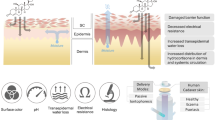Summary
The effect of skin delipidization in humans on the percutaneous penetration of hydrocortisone was investigated in a cross-over trial. The delipidizing agent was 1:1:1 trichlorethane, a common industrial organic solvent. The findings do not show any significant difference in the topical absorption of hydrocortisone with and without skin delipidization.
It was postulated that the natural skin barrier was reestablished by the metabolic cutaneous lipid regeneration concomitant with the absorption of the fatty ingredients from the cream.
Similar content being viewed by others
References
Berenson GS, Burch GE (1951) Studies of diffusion of water through dead human skin. The effect of different environmental states and of chemical alterations of the epidermis. Am J Trop Med Hyg 31:842–853
Mali JWH (1956) The transport of water through human epidermis. J Invest Dermatol 27:451–469
Onken HD, Moyer CA (1963) The water barrier in human epidermis. Arch Dermatol 87:584–590
Blank IH, Scheuplein RJ, MacFarlane DJ (1967) Mechanism of percutaneous absorption. The effect of temperature on the transport of non-electrolytes across the skin. J Invest Dermatol 49:582–589
Matoltsy AG, Downes AM, Sweeney TM (1968) Studies of the epidermal water barrier. II. Investigation of the chemical nature of the water barrier. J Invest Dermatol 50:19–26
Scheuplein R, Ross L (1970) Effects of surfactants and solvents on the permeability of epidermis. J Soc Cosm Cem 21:853–873
Sweeney TM, Downing DT (1970) The role of lipids in the epidermal barrier to water diffusion. J Invest Dermatol 55: 135–140
Scheuplein RJ, Blank IH (1971) Permeability of the skin. Physiol Rev 51:702–747
Fredriksson T (1969) Influence of solvents and surface active agents on the barrier function of the skin towards sarin. Arch Dermatol Venereol (Stockh) 49:55–58
Browning E (1965) Toxicity and metabolism of industrial solvents. Elsevier, Amsterdam London New York, pp 254–256
Hamilton A, Hardy HL (1974) Industrial toxicology. Publishing Sciences Group, Acton, MA, pp 284–285
Brown VKH, Box VL (1971) The influence of some solvents on the vascularity of skin in relation to effects on systemic intoxication by solutes. In: Toxicological problems of drug combinations. Proceedings XIII Meeting of the European Society of Drug Toxicity. Excerpta Medica, Series No. 254, Berlin, pp 205–211
Stewart RD (1971) Methyl-chloroform intoxication. Diagnosis and treatment. JAMA 215:1789–1792
Mathias CT (personal communication)
Lindsay C, Feldmann R, Maibach H (1976) Method of preparation and application of small quantities of semisolid topicals. Arch Dermatol Res 257:87–91
Anjo DM, Feldmann RJ, Maibach HI (1980) Methods of predicting percutaneous penetration in man. In: Mauvais-Jarvis P, Vicker CFH, Wepplers J (eds) Percutaneous absorption of steroids. Academic Press, London, pp 35–37
Feldmann RJ, Maibach HI (1969) Percutaneous penetration of steroids in man. J Invest Dermatol 52:89–94
Elias PM, Goerke J, Friend DS (1977) Mammalian epidermal barrier layer lipids; composition and influence on structure. J Invest Dermatol 69:535–546
Elias PM, Brown BE, Fritsch P, Goerke J, Gray M, White RJ (1979) Localization and composition of lipids in neonatal mouse stratum granulosum and stratum corneum. J Invest Dermatol 73:339–348
Smith WP, Christensen MS, Nacht S, Gans EH (1982) Effect of lipids on the aggregation and permeability of human stratum corneum. J Invest Dermatol 78:7–11
Grayson S, Elias PM (1982) Isolation and lipid biochemical characterization of stratum corneum membrane complexes: Implications for the cutaneous permeability barrier. J Invest Dermatol 78:128–135
Elias PM (1981) Epidermal lipids, membranes and keratinization. Int J Dermatol 20:1–19
Komatsu H, Suzuki M (1978) Prevention of adverse skin reactions to cosmetics via percutaneous absorption control. Cosmetics and Toiletries 93:39–48
Author information
Authors and Affiliations
Rights and permissions
About this article
Cite this article
Bucks, D.A.W., Maibach, H.I., Menczel, E. et al. Percutaneous penetration of hydrocortisone in humans following skin delipidization by 1:1:1 trichlorethane. Arch Dermatol Res 275, 242–245 (1983). https://doi.org/10.1007/BF00416669
Received:
Issue Date:
DOI: https://doi.org/10.1007/BF00416669




